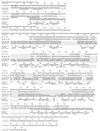The B12-dependent ribonucleotide reductase from the archaebacterium Thermoplasma acidophila: an evolutionary solution to the ribonucleotide reductase conundrum
- PMID: 8990160
- PMCID: PMC19235
- DOI: 10.1073/pnas.94.1.53
The B12-dependent ribonucleotide reductase from the archaebacterium Thermoplasma acidophila: an evolutionary solution to the ribonucleotide reductase conundrum
Abstract
A coenzyme B12-dependent ribonucleotide reductase was purified from the archaebacterium Thermoplasma acidophila and partially sequenced. Using probes derived from the sequence, the corresponding gene was cloned, completely sequenced, and expressed in Escherichia coli. The deduced amino acid sequence shows that the catalytic domain of the B12-dependent enzyme from T. acidophila, some 400 amino acids, is related by common ancestry to the diferric tyrosine radical iron(III)-dependent ribonucleotide reductase from E. coli, yeast, mammalian viruses, and man. The critical cysteine residues in the catalytic domain that participate in the thiyl radical-dependent reaction have been conserved even though the cofactor that generates the radical is not. Evolutionary bridges created by the T. acidophila sequence and that of a B12-dependent reductase from Mycobacterium tuberculosis establish homology between the Fe-dependent enzymes and the catalytic domain of the Lactobacillus leichmannii B12-dependent enzyme as well. These bridges are confirmed by a predicted secondary structure for the Lactobacillus enzyme. Sequence similarities show that the N-terminal domain of the T. acidophila ribonucleotide reductase is also homologous to the anaerobic ribonucleotide reductase from E. coli, which uses neither B12 nor Fe cofactors. A predicted secondary structure of the N-terminal domain suggests that it is predominantly helical, as is the domain in the aerobic E. coli enzyme depending on Fe, extending the homologous family of proteins to include anaerobic ribonucleotide reductases, B12 ribonucleotide reductases, and Fe-dependent aerobic ribonucleotide reductases. A model for the evolution of the ribonucleotide reductase family is presented; in this model, the thiyl radical-based reaction mechanism is conserved, but the cofactor is chosen to best adapt the host organism to its environment. This analysis illustrates how secondary structure predictions can assist evolutionary analyses, each important in "post-genomic" biochemistry.
Figures

Similar articles
-
B12-dependent ribonucleotide reductases from deeply rooted eubacteria are structurally related to the aerobic enzyme from Escherichia coli.Proc Natl Acad Sci U S A. 1997 Dec 9;94(25):13487-92. doi: 10.1073/pnas.94.25.13487. Proc Natl Acad Sci U S A. 1997. PMID: 9391052 Free PMC article.
-
Allosteric control of three B12-dependent (class II) ribonucleotide reductases. Implications for the evolution of ribonucleotide reduction.J Biol Chem. 1999 Mar 12;274(11):7182-9. doi: 10.1074/jbc.274.11.7182. J Biol Chem. 1999. PMID: 10066778
-
Coenzyme B12-dependent ribonucleotide reductase: evidence for the participation of five cysteine residues in ribonucleotide reduction.Biochemistry. 1994 Oct 25;33(42):12676-85. doi: 10.1021/bi00208a019. Biochemistry. 1994. PMID: 7918494
-
Ribonucleotide reductases: radical enzymes with suicidal tendencies.Biochem Soc Trans. 1993 Aug;21 ( Pt 3)(3):727-30. doi: 10.1042/bst0210727. Biochem Soc Trans. 1993. PMID: 8224499 Review.
-
The function of adenosylcobalamin in the mechanism of ribonucleoside triphosphate reductase from Lactobacillus leichmannii.Curr Opin Chem Biol. 1998 Oct;2(5):650-5. doi: 10.1016/s1367-5931(98)80097-5. Curr Opin Chem Biol. 1998. PMID: 9818192 Review.
Cited by
-
Targeting the Large Subunit of Human Ribonucleotide Reductase for Cancer Chemotherapy.Pharmaceuticals (Basel). 2011 Oct 13;4(10):1328-1354. doi: 10.3390/ph4101328. Pharmaceuticals (Basel). 2011. PMID: 23115527 Free PMC article.
-
Isolation of the gene for the B12-dependent ribonucleotide reductase from Anabaena sp. strain PCC 7120 and expression in Escherichia coli.J Bacteriol. 2002 Dec;184(23):6544-50. doi: 10.1128/JB.184.23.6544-6550.2002. J Bacteriol. 2002. PMID: 12426342 Free PMC article.
-
Ribonucleotide reductases in the twenty-first century.Proc Natl Acad Sci U S A. 1998 Mar 17;95(6):2723-4. doi: 10.1073/pnas.95.6.2723. Proc Natl Acad Sci U S A. 1998. PMID: 9501154 Free PMC article. No abstract available.
-
Methyl-RNA: an evolutionary bridge between RNA and DNA?Chem Biol. 2000 Dec;7(12):R207-16. doi: 10.1016/s1074-5521(00)00042-9. Chem Biol. 2000. PMID: 11137821 Free PMC article.
-
Integrating protein structures and precomputed genealogies in the Magnum database: examples with cellular retinoid binding proteins.BMC Bioinformatics. 2006 Feb 23;7:89. doi: 10.1186/1471-2105-7-89. BMC Bioinformatics. 2006. PMID: 16504077 Free PMC article.
References
Publication types
MeSH terms
Substances
LinkOut - more resources
Full Text Sources

